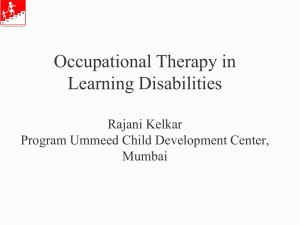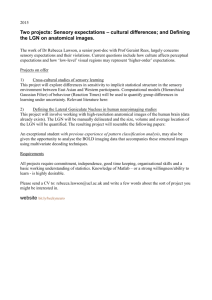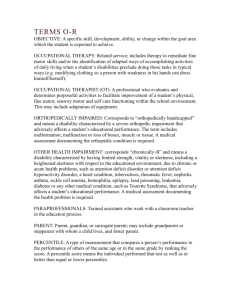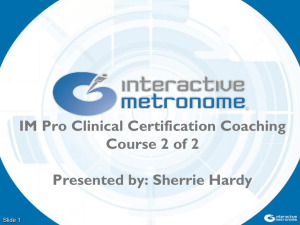Occupational Therapists` Test Descriptions for use in myIDEA
advertisement
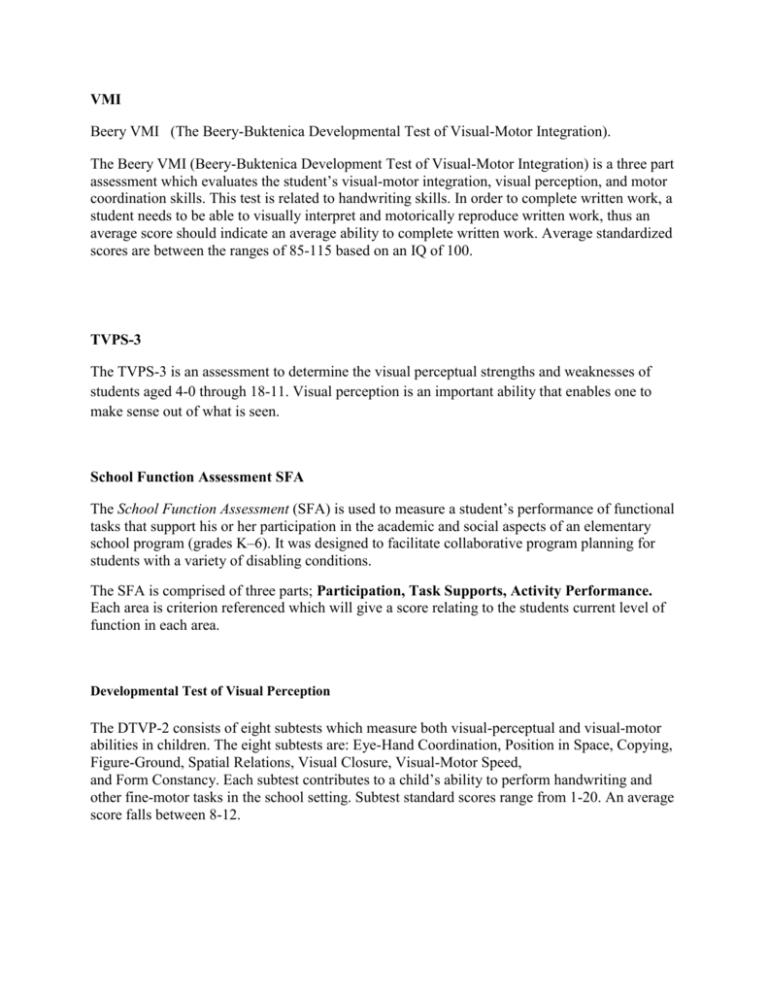
VMI Beery VMI (The Beery-Buktenica Developmental Test of Visual-Motor Integration). The Beery VMI (Beery-Buktenica Development Test of Visual-Motor Integration) is a three part assessment which evaluates the student’s visual-motor integration, visual perception, and motor coordination skills. This test is related to handwriting skills. In order to complete written work, a student needs to be able to visually interpret and motorically reproduce written work, thus an average score should indicate an average ability to complete written work. Average standardized scores are between the ranges of 85-115 based on an IQ of 100. TVPS-3 The TVPS-3 is an assessment to determine the visual perceptual strengths and weaknesses of students aged 4-0 through 18-11. Visual perception is an important ability that enables one to make sense out of what is seen. School Function Assessment SFA The School Function Assessment (SFA) is used to measure a student’s performance of functional tasks that support his or her participation in the academic and social aspects of an elementary school program (grades K–6). It was designed to facilitate collaborative program planning for students with a variety of disabling conditions. The SFA is comprised of three parts; Participation, Task Supports, Activity Performance. Each area is criterion referenced which will give a score relating to the students current level of function in each area. Developmental Test of Visual Perception The DTVP-2 consists of eight subtests which measure both visual-perceptual and visual-motor abilities in children. The eight subtests are: Eye-Hand Coordination, Position in Space, Copying, Figure-Ground, Spatial Relations, Visual Closure, Visual-Motor Speed, and Form Constancy. Each subtest contributes to a child’s ability to perform handwriting and other fine-motor tasks in the school setting. Subtest standard scores range from 1-20. An average score falls between 8-12. Sensory Processing Measure (SPM) The (SPM) is an integrated system of rating scales that enables the assessment of sensory processing issues, praxis, and social participation in elementary school aged children. The Sensory Processing Measure yields scores for the following eight areas: Social Participation (SOC), Vision (VIS), Hearing (HEA), Touch (TOU), Body Awareness (BOD), Balance and Motion (BAL), Planning and Ideas (PLA) and Total Sensory Systems (TOT). The standard score for each area classifies the child’s functioning into one of three interpretive ranges: Typical (the child’s behavior and sensory functioning is similar to that of typical children), Some Problems (mild- to-moderate difficulties in behavioral and sensory functioning), and Definite Dysfunction (significant sensory processing problem that may have a noticeable effect on the child’s daily functioning). BOT-2 The BOT 2 (Bruininks-Oserectsky Test of Motor Proficiency-Second Edition) tests: Fine Motor Precision, Fine Motor Integration, Manual Dexterity, Bilateral Coordination, Balance, Running Speed and Agility, Upper-Limb Coordination, and Strength. The areas of concern for occupational therapists in evaluating school function are fine motor precision, fine motor integration, manual dexterity and upperlimb coordination. These factors are used in skills evaluated by OT such as scissors skills, endurance and strength to complete classroom tasks, ability to hold and manipulate utensils and tools used in the classroom such as a pair of scissors, paintbrush or pencil. The point scores are converted into standardized scores. Standardized scores ranging from 30 and below are at least 2 standard deviations below the mean (or average score). Bayley Scales of Infant and Toddler Development, Third Edition Motor Scale (Bayley-III Motor Scale) is an assessment instrument that is used to help identify developmental motor delays in young children between the ages of 1 month and 42 months. This test provides four types of norm-referenced scores including: percentile ranks, scaled scores, composite scores, and growth scores. Peabody Developmental Motor Scales, Second Edition (PDMS-2) is a standardized assessment designed to assess a child’s fine and gross motor skills from birth to 5 years of age. This test is composed of 4 subtests in the gross motor area: reflexes, stationary, locomotion, object manipulation, and 2 subtests in the fine-motor area: grasping and visual motor integration. The PDMS-2 provides raw scores, age equivalents, percentiles, standard scores and composite quotients. Sensory Profile The Sensory Profile is a caregiver/teacher questionnaire that contains statements about children’s responses to sensory events in daily life and in a classroom environment. Caregivers and educators report how frequently the child engages in each of the 125 behaviors. The data is used to determine whether aspects of sensory processing might be contributing to performance challenges in the school environment. There are three sections on the Sensory Profile, i.e., Sensory Processing, Modulation and Behavior, and Emotional Responses. - - - The Sensory Processing section contains 6 subsections that evaluate the child’s responses to specific sensory information, including auditory, visual, response to movement (vestibular), touch, multisensory experience and oral sensory experiences. The Modulation section contains 5 subsections that evaluate various combinations of responses reflecting the child’s ability to receive sensory input and organize it for an appropriate response. The Behavior and Emotional response section contains 3 subsections that evaluate behavioral outcomes that occur that are related to sensory processing ability. The Print Tool The Print Tool is a functional assessment that evaluates the components of handwriting which include; memory, orientation, placement, size, start, sequence, and control. Percentage scores are compared to expectation levels of same age peers, to determine areas of difficulty for students. Overall score for capital letters:___%, overall score for lowercase letters:___%, and overall score for number 1-9:___%. The total overall score:___%. The score for letter spacing in-between litters in a word:___% and the score for spacing in-between words in a sentence:___%. The Print Tool is a functional assessment that evaluates the components of handwriting which includes memory, orientation, placement, size, start, sequence, and control. Percentage scores are compared to expectation levels of same age peers, to determine areas of difficulty for students. Overall score on capital letters was __% with __% memory, __% orientation, __% placement, __% size, __% start, __% sequencing, and __% control. Overall score on lowercase letters was __% with __% memory,__% orientation, __% placement, __% sizing, __% start, __% sequencing, and __% control. Overall score for numbers 1-9 was __% with __% memory, __% orientation, __% placement, __% sizing,__% start, __% sequencing, and __% control. The score for letter spacing in between letters in a word was __% and the score for spacing in between words in a sentence was__%. Evaluation Tool of Children’s Handwriting (ETCH) The ETCH is used to evaluate manuscript and cursive writing skills of children in Grades 1 through 6. The ETCH evaluates the following components of writing; letter formation, spacing, size, an alignment. It also evaluates sensory motor skills used to manipulate the writing utensil and paper. The ETCH evaluates upper-case/lower-case letters, numerals, near/far point copying writing from dictation and sentence composition.

